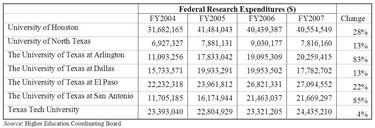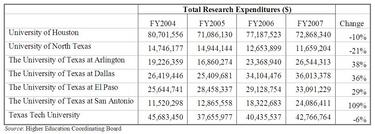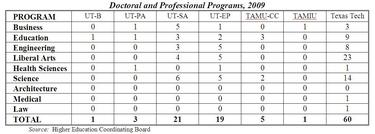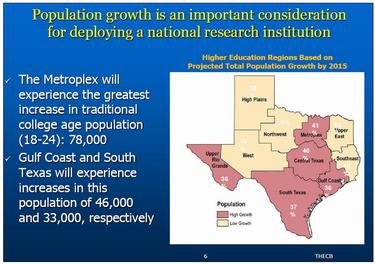
From the Senator's Desk . . .
June 9, 2009
The Senate recently passed three bills...aimed at moving Texas' seven emerging research universities toward tier one status. The statewide consensus that something must be done to make our institutions of higher education more competitive on a national and global scale is long overdue...With that said, however, I strongly objected to certain criteria in S.B. 1560, as I believe the bill as written will effectively result in the coronation of the University of Houston and Texas Tech University rather than a true competition to incentivize all seven of Texas' emerging research institutions.
Written by Senator Eliot Shapleigh, www.shapleigh.org
The Honorable David Dewhurst
Lieutenant Governor
State of Texas
Austin, Texas 78701
VIA HAND DELIVERY
Re: Tier One and Texas Borderland Universities
Dear Governor Dewhurst:
As you know, the Senate recently passed three bills, S.B. 9 by Senator Zaffirini, S.B. 1560 by Senator Duncan, and S.J.R. 35 by Senator Duncan, aimed at moving Texas' seven emerging research universities toward tier one status. The statewide consensus that something must be done to make our institutions of higher education more competitive on a national and global scale is long overdue.
With that said, however, I strongly objected to certain criteria in S.B. 1560, as I believe the bill as written will effectively result in the coronation of the University of Houston and Texas Tech University rather than a true competition to incentivize all seven of Texas' emerging research institutions. With the University of California (UC) System now birthing an eighth public national research institution at UC-Merced, we can learn many lessons on how to develop and fund excellence. One thing we should not continue is a historic underfunding of Border universities, the ramifications of which are still with us today.
In 1970, the NAACP filed suit against the U.S. Department of Health, Education, and Welfare, alleging that the agency had failed to implement and enforce Title VI of the Civil Rights Act of 1964 to eliminated racial discrimination in higher education. The NAACP sought a court order requiring the Department to implement Title VI and initiate litigation against ten states that had been found to be in noncompliance.
In 1973, an order was entered requiring the U.S. Department of Education to investigate higher education in six states, including Texas, and then issue guidelines for desegregation efforts in those states. The Department's Office for Civil Rights (OCR) investigated and concluded that Texas had failed to eliminate the vestiges of its former racially dual system of public higher education. To avoid enforcement proceedings, Governor William Clements developed a plan in compliance with OCR guidelines to desegregate and increase the representation of minorities in Texas' institutions of higher education. That plan, the Texas Educational Opportunity Plan for Public Higher Education, was federally monitored and effective from 1983 to 1988.
A second five-year plan initiated by Governor Clements was effective from 1989 to 1994 and sustained the efforts of the first plan. A third plan effective in 1994 and designed to take Texas into the next century was created under the leadership of Governor Ann Richards to continue and build upon the previous efforts.
Additionally, in 1989, Texas implemented the South Texas Border Initiative (STBI). The basic catalyst for the STBI was a 1987 lawsuit, LULAC v. Richards, filed by the Mexican American Legal Defense and Education Fund (MALDEF). The suit claimed that the state had discriminated against Hispanic students by not adequately funding higher educations institutions along the Border. Ideas then dominant in the Higher Education Coordinating Board were best summarized by former Coordinating Board Commissioner Kenneth Ashworth, who stated in 1993 that "[t]o expect that if we had a limited doctoral availability that we should expect Texans to travel to El Paso because that's the best place to have an additional doctoral program is kind of expecting a little too much." Ashworth's argument is similar to those voiced against Laredo, Brownsville, and McAllen, but of course not Texas Tech.
MALDEF argued that this low funding denied Hispanics the same access and opportunity in higher education that other students experienced throughout the state. A lower court ruled in favor of MALDEF, though the Texas Supreme Court later overturned the ruling. Nonetheless, the suit caught the attention of the public, and state lawmakers responded with the STBI in the 71st Legislature. Through STBI, the Legislature developed a $460 million package for the nine four-year colleges and universities located throughout the Border region.
As a result of these efforts and strong representation in the Legislature, Border universities are no longer considered second-class institutions during the budgetary process. Border schools, especially recently, compete both statewide and nationally for student talent and research funding. For example, the following chart shows the growth in federal research expenditures—the single most relevant category when determining the potential to reach tier one status:
Click here to view larger image.
The growth in total research expenditures show similar patterns:
Click here to view larger image.
During the floor debate of S.B. 1560, we offered two amendments in an attempt to level the playing field for all seven emerging research universities. First, we tried to amend one of the criteria a school could meet in order to access the pot of increased state funding. The criteria stated that an institution must have awarded 200 PhDs during each of the last two academic years. Our amendment would have reduced this to 100 PhDs and allowed a school to qualify had they shown a net 20 percent growth of the number of PhDs awarded over the past three fiscal years. This would allow border universities like the University of Texas at El Paso (UTEP) and the University of Texas at San Antonio (UTSA) to compete alongside the other five schools that have been given a large head start in the number of doctoral programs. Unfortunately, this amendment was defeated on a vote of 20 to 11.
Here's why we offered that amendment. The residual effect of historic discrimination is that the state's majority-Hispanic institutions have dramatically low numbers of PhD programs. Hereinbelow is a breakdown by campus of doctoral and professional programs at border universities compared to Texas Tech. As you can see, Texas Tech's doctoral and professional programs exceed that of six of the Border's majority-Hispanic serving institutions by 10 programs—hence the focus on S.B. 1560's PhD criteria:
Click here to view larger image.
We also offered an amendment to reflect what Commissioner Raymund Paredes stated during the March 25 Higher Education Committee hearing on the Tier One bills. When prioritizing the key metrics to identify national research universities, Commissioner Paredes pointed out the importance of demographic and economic considerations, including population trends and the economic and business infrastructure of a locality. After all, national research universities have to be able to show collaboration between local and regional industries and utilize and take advantage of shared resources. Below please find a slide from Commissioner Paredes' March 25 presentation.
Click here to view larger image.
Our amendment would have allowed a school to meet an additional criteria provided that the institution is located in a population center with a local and regional economic infrastructure capable of facilitating the long-term success of a national research institution. El Paso, San Antonio, and the Valley would have greatly benefited from this amendment, as all have dynamic economies capable of sustaining growth and working closely with the local universities. Unfortunately, in deference to Senator Duncan, this amendment was voted down 19 to 12.
I point these amendments out because their defeat are representative of the larger problem: the historic underfunding of Border universities that has resulted in them playing catch up to the rest of the state. Given that Texas is majority-minority today and will be majority-Hispanic by 2020, I am asking you to set the stage for a second STBI in order to reverse decades of institutionalized and systemic discrimination against our Borderlands universities.
Finally, systemic issues with funding that affect Border universities also impact the other public institutions of higher education across our state. To put it bluntly, leadership in Austin does not place the appropriate value on ensuring Texas' competitiveness in higher education. In response to our S.B. 1564, the Higher Education Coordinating Board recently compared the average fiscal year 2006-07 state appropriations per full time student equivalent for the seven emerging research universities in Texas to their peer national research institutions in other states such as the Universities of Buffalo, Arizona, Kansas, Maryland, Missouri, Nebraska, and Wisconsin. That Texas has essentially lowered expectations by comparing to peers like Buffalo and not Michigan is a story in itself.
The Coordinating Board estimated that the average 2006-07 state appropriations for the seven Texas universities was $5,160, while the average for the peer institutions was $11,867—an astounding difference of $6,707. How can we expect the seven to compete nationally when the Legislature is forcing them to fight for talent and research funding with such dramatic disposition in funding? One result of this underfunding is that Texas' public and private universities have 52 members of the National Academy of Sciences (NAS), while California's have an astounding 625. In 2008, state appropriations per full time student equivalent at the University of California-Berkeley, the crown jewel of the UC system, was $13,857, compared to $6,576 at UT-Austin. This helps explain why Berkeley currently has 127 members in the NAS to UT-Austin's 15.
Even the Governor's business supporters agree. Recently, the Select Commission on Higher Education and Global Competitiveness, created last session by a resolution sponsored by our office, released a report examining how to make Texas competitive once again. The report found:
Texas is not globally competitive. The state faces a downward spiral in both quality of life and economic competitiveness if it fails to educate more of its growing population (both young and adults) to higher levels of attainment, knowledge and skills. The rate at which educational capital is currently being developed is woefully inadequate. Texas also needs an innovation-based economy in all the state's regions that can fully employ a more capable workforce. It must generate more external research funding, and commercialize ideas and intellectual property at a volume substantially greater than currently taking place.
I look forward to working with you to ensure Texas can once again compete on a national and global level. To compete in a knowledge-based 21st century, our states very future depends on it. Current talk of additional tier one universities in Texas is a Potemkin dream without funding. At best, even with the funding in the tier one bills moving through the Legislature, Texas could be decades away from new tier ones. China and India have learned that exporting valuable human capital to the U.S. is an unsustainable model. Soon we will understand what competition from those countries will represent in innovation, ideas, and prosperity, and what failed leadership has cost our state.

Eliot Shapleigh
ES/de
CC: Texas Border Legislators
Texas Legislature\Lt. Gov\Dewhurst\DewhurstD Tier One.doc



